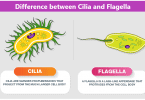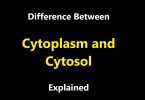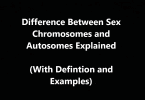Chromosomes and chromatids are involved in cell division. They contain the genetic information of the cell since they have genes on them. There is no major Difference between Chromosomes and Chromatids except that chromatid is a single unit that combines with other chromatids to form a chromosome, which is a complete unit.
Also See: Difference Between Diploblastic and Triploblastic
Chromosomes: Definition and Functions
A chromosome is a molecule that contains part of the genetic information or all genetic information of any organisms. Chromosomes are not visible under the microscope until they are in metaphase stage. At that stage, they are visible under the light microscope and all chromosomes appear arranged on the metaphase plate.
All organisms have a different number of chromosomes. For example, humans have 23 sets of chromosome or 46 chromosomes. The genetic information is present on these chromosomes and any mutation or defect in these is responsible for causing genetic disorders and disease.
Prokaryotes also have chromosomes, with bacteria normally having a single circular one but some bacteria may have linear chromosome. The number of base pairs on these chromosomes ranges from 130,000 to 14,000,000. In eukaryotes, chromosomes are made up of chromatin fiber which is further made up of nucleosomes that contain DNA and histone proteins.
In the normal resting state, the cell contains chromatin since it allows long DNA molecules to reside in the nucleus. However, during cell division, these fibers condense and they form chromosomes that further go into stages of cell division.
Chromatid: Definition and Functions
Chromatid refers to one of the copies of the chromosomes. So, the only Difference between Chromosomes and Chromatids is the number. During DNA replications, identical sister chromatids are produced. On the other hand, chromosomes that come from mother and father have the same set of genes but the traits or alleles on these genes are different.
Two chromatids that joint to form a chromosome are called sister chromatids and they are joined at the centromere. Proteins form a cohesin complex which helps in this cohesion. This cohesion is important because it helps the chromosomes in their arrangement on the metaphase plate and their segregation for forming daughter cells.
During mitosis, sister chromatids are separated and they go to separate daughter cells. During metaphase, these chromatids align on the metaphase plate and in the anaphase stage, they are separated and incorporated into different daughter cells. Each chromatid is considered a chromosome for the daughter cell.
They de-condense again to form chromatin material in the cell. During the DNA repair process, Sister chromatid exchange takes place which is the exchange of genetic material. During meiosis, non-soster chromatids overlap to form chiasmata.
Summary of Difference between Chromosomes and Chromatids:
- The primary Difference between Chromosomes and Chromatids is that chromosomes are in pair while chromatid is one part of the chromosome.
- They are both important in terms of cell division since they contain genetic information.
- Different chromosomes contain genes for different genes, such as physical appearance, diseases, and mental abilities.
- During mitosis, sister chromatids separate and are considered chromosomes when they go to separate daughter cells in the telophase state.







Leave a Comment
You must be logged in to post a comment.